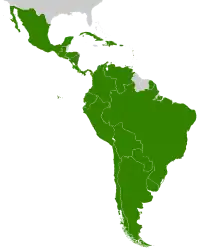Mesoamerican cuisine
Mesoamerican cuisine – (covering Belize, El Salvador, Guatemala, Honduras, Nicaragua, northern Costa Rica and Mexico)[1] has four main staples: maize (many varieties based on what climate it is grown in),[2] beans,[3] squash and chili.[4] Other plant-based foods used include: amaranth, avocado,[5] cassava, cherimoya, chia, chocolate,[6] guava,[7] nanche, pineapple, sapodilla,[8] sweet potatoes, yucca and zapote.[9]
Historically, various methods and techniques were employed to store, prepare and preserve the foods, most of which remain in use today.[10] Hernán Cortés introduced rice and wheat to Mesoamerica, prior to which time milpa (known as the cornfield)[5] was one of the main sources of sustenance.[11]
Some traditional foods featured in the cuisine include: Atole (a drink made using masa)[12] and Chocolate Atole (with the addition of chocolate) also known as champurrado.[13] Two classic maize dishes are: boiling maize in water and lime, mixing with chili peppers and eating as gruel; dough preparation for flat cakes, tamales and tortillas.[14] Edible foam is another popular food item, sometimes even regarded as sacred.[15]
While squashes were cooked for food, dried gourds were repurposed for storage[16] or used during battles with embers and chilies, wrapped in leaves and used as chemical warfare.[17]
History
_(14725547206).jpg.webp)
- 7200 BCE: use of chilies
- 6,700 BCE: harvesting and teosinte planting
- 4000 BCE: use of squash
- 2000 BCE: cultivation began
- 1500 BC: chocolate with the Olmec civilization in Mesoamerica.[18]
Animals
The animals used in Mesoamerican cuisine were mainly dogs, turkeys and the Muscovy duck.[19]
Chocolate
The Mesoamericans began making fermented drinks using chocolate in 450 BC using the Theobroma cacao (cocoa tree).[20] Once sugar was used to sweeten it rather than spices, it gained popularity[21] and was used in feasts. Toasted cacao beans were ground (sometimes with parched corn) and then the powder was mixed with water. This was beaten with a wooden whisk until foamy. Vanilla orchid pods or honey were used as flavor enhancers.[22] Chocolate was also seen as an energy drink and a libido increaser as recorded by Moctezuma II who drank 50 cups a day from a golden goblet.[23]
References
- "Divine Food". www.imj.org.il. 2019-10-06. Retrieved 2021-08-11.
- Smith, Michael E. (2013-03-01). The Aztecs. John Wiley & Sons. ISBN 978-1-118-25719-7.
- "Mesoamerica. Pizza With Savour Of Aztec Cuisine". www.southworld.net. Retrieved 2021-08-11.
- Morganfield, T. L. (2013-09-02). "Food in Mesoamerica - The Four Staples (History)". T. L. Morganfield. Retrieved 2021-08-11.
- "The Mesoamerican Milpa". edibleaustin.com. Retrieved 2021-08-11.
- McNeil, Cameron L. (2006). Chocolate in Mesoamerica: A Cultural History of Cacao. University Press of Florida. ISBN 978-0-8130-2953-5.
- Gómez-Maqueo, Andrea; Escobedo-Avellaneda, Zamantha; Welti-Chanes, Jorge (2020-11-07). "Phenolic Compounds in Mesoamerican Fruits—Characterization, Health Potential and Processing with Innovative Technologies". International Journal of Molecular Sciences. 21 (21): 8357. doi:10.3390/ijms21218357. ISSN 1422-0067. PMC 7664671. PMID 33171785.
- McDonald, Michael R. (2009-06-22). Food Culture in Central America. ABC-CLIO. ISBN 978-0-313-34768-9.
- "Mexican Culinary Culture by ChefsProject.com". chefsproject.com. Retrieved 2021-08-11.
- Garcia Acosta, V. (1992). "[Mesoamerican food and processing techniques]". Quipu. 9 (2): 135–148. ISSN 0185-5093. PMID 11640797.
- Eastsider, The. "A Mexican restaurant without rice? Welcome to Mesoamerican cuisine in Boyle Heights". The Eastsider LA. Retrieved 2021-08-11.
- Hammond, David. "Making atole, a warm, liquid gift from ancient Mexico". chicagotribune.com. Retrieved 2021-08-11.
- "Mesoamerican Cuisine". worldfood.guide. Retrieved 2021-08-11.
- Chapala (2017-09-05). "How the Maya Civilization Influenced Today's Mexican Food". Chapala Mexican Restaurant. Retrieved 2021-08-11.
- Stross, Brian (2011-12-01). "Food, Foam and Fermentation in Mesoamerica". Food, Culture & Society. 14 (4): 477–501. doi:10.2752/175174411X13046092851352. ISSN 1552-8014. S2CID 152733774.
- "The Aztec or Mexica bottle gourd". www.mexicolore.co.uk. Retrieved 2021-08-11.
- "The Food Timeline--Aztec, Maya & Inca foods". www.foodtimeline.org. Retrieved 2021-08-11.
- "Medicinal and Ritualistic Uses for Chocolate in Mesoamerica". HeritageDaily - Archaeology News. 2020-03-06. Retrieved 2021-08-11.
- Nell Lewis, for (23 March 2018). "How the ancient Maya reared dogs for food". CNN. Retrieved 2021-08-11.
- "Mesoamerica | Arizona Museum of Natural History". www.arizonamuseumofnaturalhistory.org. Retrieved 2021-08-11.
- Norton, Marcy (2006). "Tasting Empire: Chocolate and the European Internalization of Mesoamerican Aesthetics". The American Historical Review. 111 (3): 660–691. doi:10.1086/ahr.111.3.660. ISSN 0002-8762. JSTOR 10.1086/ahr.111.3.660.
- "Trove". trove.nla.gov.au. Retrieved 2021-08-11.
- "9. The Horse Who Drank the Sky", The Horse Who Drank the Sky, Rutgers University Press, pp. 206–234, 2020-12-31, doi:10.36019/9780813544960-011, ISBN 978-0-8135-4496-0, retrieved 2021-08-11
